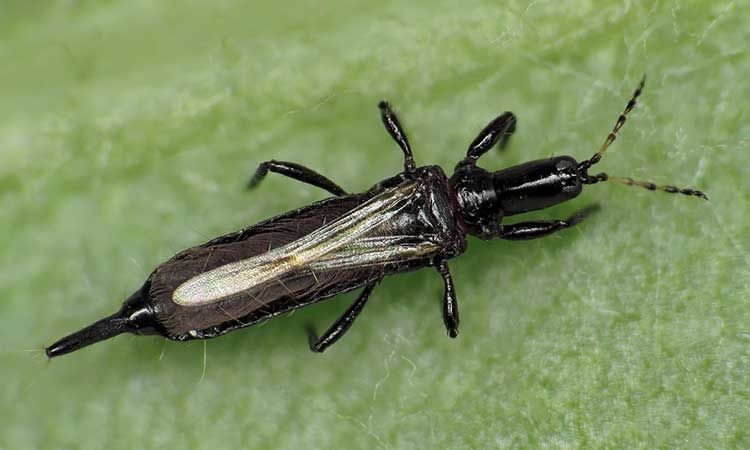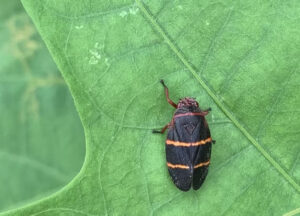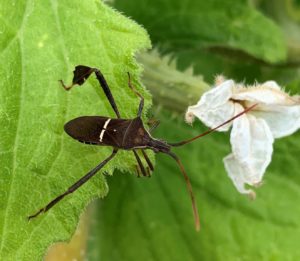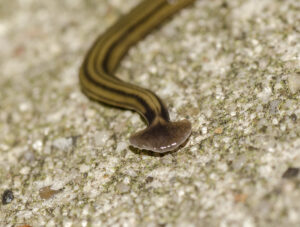Thrips are tiny insects with slender bodies that are difficult to see without a magnifying glass. They measure a mere 1/25th to 1/50th of an inch long and vary in color from pale yellow to brown to black. Even though they have two sets of fringed wings, they are not good flyers and may rely on the wind to carry them to a new location.
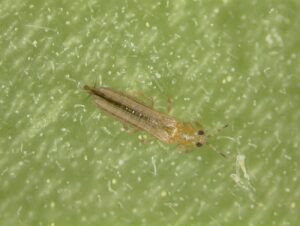
Nymphs are smaller than the adults. They are light green to yellow, and a few species, like the predatory thrips, are red-orange in the larval stage. They do not have fully developed wings at this stage.
How to Quickly Identify
Because of their size, thrips can be difficult to detect, but you can confirm their presence by shaking a leaf over a piece of paper. If the flakes that fall onto the paper are somewhat slender, oval, and grain-sized, chances are they are thrips. Small black specks or frass will also be noticeable. Frass is insect excrement. The damage they inflict can also help to determine if they are present.
Damage to Plants
Although thrips are small, they can inflict significant damage to plants. The females lay their eggs in leaf, stem or flower bud tissue via an ovipositor. The egg nest resembles small bumps on the tissue. Sometimes, leaf galls will develop where eggs have been deposited.
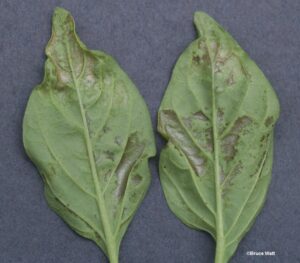
Thrips are sap-suckers, which means they will tunnel or burrow through plant tissue, inject enzymes that dissolve the tissue, and suck it out. As a result, the leaves will be flattened or thinned and have silver, white, or yellow markings that eventually turn brown or rust colored. As the infection spreads, the leaves will curl.
Pepper plants, including the flowers, are a favorite of thrips, plus watermelon plants, chamomile, avocado, onions, hibiscus, and impatiens, to name a few more. They also eat the outer skin of fruit, such as bananas and citrus, leaving scarred skin with silvery-white patches.
Several species of thrips feed on pollen and fungal spores, causing little to no damage to plants. An exception would be flowering plants like orchids, in which case, the flower’s lifespan may be reduced. Other species are considered beneficial because they feed on mites, aphids, scale insects, and other pests.
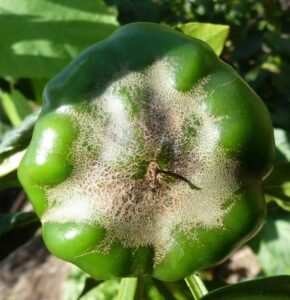
In addition, to tissue damage, thrips can also be vectors of viruses such as tomato spotted wilt virus, capsicum chlorosis virus, impatiens necrotic spot virus, and the iris yellow spot virus, which infects onions.
Life Cycle
Adult thunderflies, as thrips are also known, overwinter in bark, mulch, and plant debris. In the spring, they mate only once or twice, but this will be enough to fertilize all of the female’s eggs. The eggs are deposited in the tissue of leaves, stems, and flower buds. Some species will lay eggs in the hollow created by a folded leaf or simply on the leaf’s surface. Three to five days later, nymphs will hatch and transition through two feeding stages as larvae and two non-feeding stages as prepupa and pupa, before becoming an adult two to three days later.
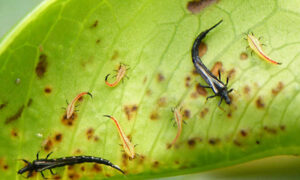
In the prepupa and pupa stages, the majority of thrip species will either travel or drop to the soil or plant folds. Greenhouse thrips, on the other hand, pupate on the surfaces of the lower leaves. The entire process, from egg to adult, takes place in as little as one to two weeks, depending on the species and the temperature, as warm weather accelerates the cycle.
Adult thrips live between thirty to sixty days. A dozen generations or more are produced each season, from spring to fall.
This article contains affiliate links. If you make a purchase using one of these links, I will receive a very small commission at no additional cost to you, and it will help me maintain this website. Rest assured, I only recommend products I actually like!
How to Treat Thrips
Here are the top organic methods for getting rid of thrips.
Blast of Water – Like aphids, thrips are relatively weak creatures. A strong blast of water can knock thrips off of the plant. In addition, you will need to treat the plant with neem oil to get rid of the remaining bugs.
DIY Neem Oil Spray – To make an effective DIY organic solution, add 1 teaspoon of pure cold pressed neem oil containing the naturally occurring azadirachtin (the ingredient that makes neem oil effective), and ½ teaspoon of a non-chemical soap, like Dr. Bonner’s, to 32 ounces of water in a garden sprayer. Mix well. Do a test spray first and wait 24 to 48 hours to make sure there is no damage to the plant. If there is damage, dilute recipe and retest. Spray in the entire plant, including the soil, early morning or at dusk, otherwise, exposure to the sun can cause leaf burn. To increase the recipe, add 4 teaspoons of neem oil to 2 teaspoons of Dr. Bonner’s to one gallon of water. Use a gallon-sized pump sprayer to apply. Reapply in five to seven days. You can learn more about neem oil in this helpful article.
Blue Sticky Traps – You can also place blue sticky traps in the growing area to both monitor pest activity and trap any that are present. Blue traps instead of the yellow sticky traps are often the preferred color choice when beneficial insects are also present as they, too, will be attracted to yellow ones.
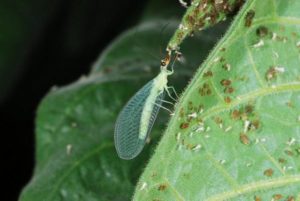
Release Predatory Insects – Green lacewings and ladybugs can help control thrip populations. Beneficial nematodes (Sf) can help control thrips that are developing in the soil.
Plants to Repel or Resist – Include plants in your garden that are known to repel many species of thrips, like basil, garlic, chives, and catnip. Also, look for plant varieties that are resistant to thrip attacks.
Mistaken Identity
Sometimes thrips can be confused with Septoria leaf spot (a plant fungal disease) or vice versa because the black spores resemble thrip frass or excrement. You can tell the difference because the spores do not move when touched, whereas the excrement is easily disturbed.
Thrips and their frass may also be confused with aphids or spider mites. Aphids generally leave a sticky residue that attracts ants, whereas thrips do not. Mites create very small webs, and thrips do not. Follow the links to learn more.
If you discover thrips or the damage they cause in your garden, you now know how to identify and eliminate them.
Thank you for reading this article! If you found it helpful, please consider sharing it with others via email and social media!
